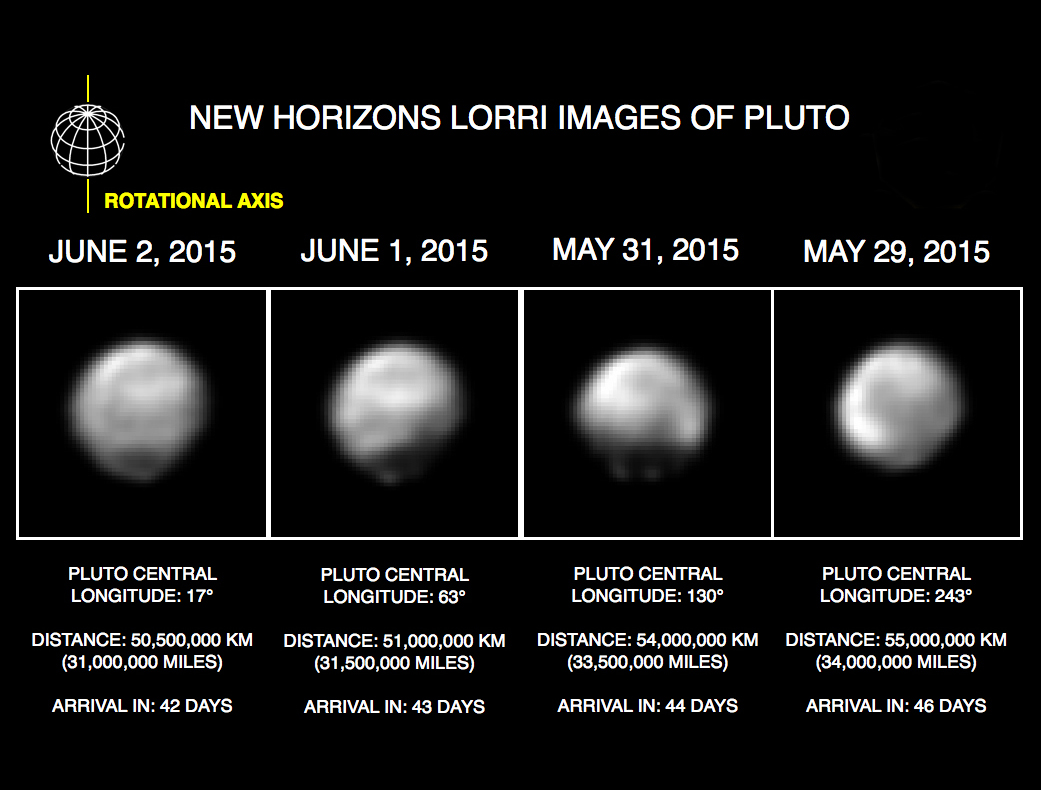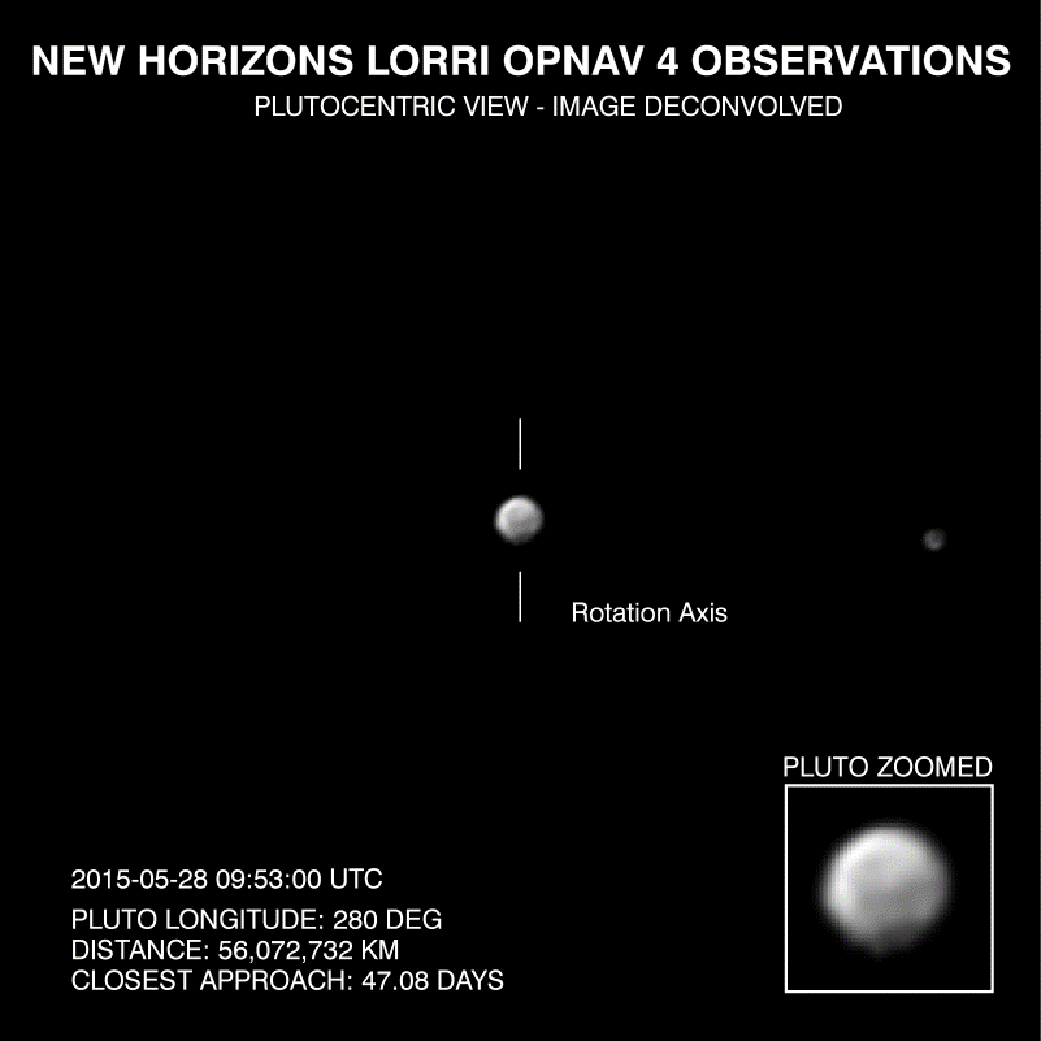One Month from Pluto, NASA Probe Sees Dwarf Planet's Many Faces
The many "faces" of Pluto are visible in new images by NASA's New Horizons probe, which is only one month away from the first-ever close encounter with the dwarf planet.
This week, NASA released what it called "the best views ever obtained of the Pluto system" taken by New Horizons, which will make its closest approach of the dwarf planet starting July 14. A video of the Pluto new images reveals the many "faces" of this petite planetary object — that is, the photos show a complete 360 degree panorama of the dwarf planet's surface. The pictures reveal regions of light and dark, and many shades of gray in between, that hint at the presence of surface features.
"We're squeezing as much information as we can out of these images, and seeing details we've never seen before," said New Horizons Project Scientist Hal Weaver, in a statement from NASA. "We've seen evidence of light and dark spots in Hubble Space Telescope images and in previous New Horizons pictures, but these new images indicate an increasingly complex and nuanced surface. Now, we want to start to learn more about what these various surface units might be and what's causing them. By early July we will have spectroscopic data to help pinpoint that." [More Amazing Pluto Photos by New Horizons]

New Horizons has traveled nearly 3 billion miles in just under 10 years to reach Pluto. It is the first probe to ever make a close study of the planet, and it is already returning images of the system that are of higher quality than those taken by the Hubble Space Telescope. (However, Hubble has still returned some great science about Pluto. Recently, scientists using Hubble data revealed new information about the very strange motions and colors of Pluto's five moons).
The new images, taken by the Long Range Reconnaissance Imager (LORRI), seem to show a very lumpy, nonspherical-looking Pluto, but this is the result of the technique used to create the images, called deconvolution, as well as Pluto's large variations in surface brightness, according to the same statement. In addition, the contrast in the images has been "stretched to bring out additional details."
The deconvolution technique has been used by the New Horizons team to identify surface markings on Pluto, including a bright area at one pole that scientists think is a polar cap. Deconvolution has been known to create "false details," or artifacts, in the images, so NASA said the spacecraft team will be carefully reviewing images produced with this technique.

"Even though the latest images were made from more than 30 million miles away, they show an increasingly complex surface with clear evidence of discrete equatorial bright and dark regions—some that may also have variations in brightness," said Alan Stern, New Horizons' principal investigator. "We can also see that every face of Pluto is different and that Pluto's northern hemisphere displays substantial dark terrains, though both Pluto's darkest and its brightest known terrain units are just south of, or on, its equator. Why this is so is an emerging puzzle."
Get the Space.com Newsletter
Breaking space news, the latest updates on rocket launches, skywatching events and more!
As of yesterday (June 11), New Horizons was approximately 2.9 billion miles (4.7 billion kilometers) from Earth and just 24 million miles (39 million kilometers) from Pluto.
Follow Calla Cofield @callacofield. Follow us @Spacedotcom, Facebook and Google+. Original article on Space.com.
Join our Space Forums to keep talking space on the latest missions, night sky and more! And if you have a news tip, correction or comment, let us know at: community@space.com.

Calla Cofield joined Space.com's crew in October 2014. She enjoys writing about black holes, exploding stars, ripples in space-time, science in comic books, and all the mysteries of the cosmos. Prior to joining Space.com Calla worked as a freelance writer, with her work appearing in APS News, Symmetry magazine, Scientific American, Nature News, Physics World, and others. From 2010 to 2014 she was a producer for The Physics Central Podcast. Previously, Calla worked at the American Museum of Natural History in New York City (hands down the best office building ever) and SLAC National Accelerator Laboratory in California. Calla studied physics at the University of Massachusetts, Amherst and is originally from Sandy, Utah. In 2018, Calla left Space.com to join NASA's Jet Propulsion Laboratory media team where she oversees astronomy, physics, exoplanets and the Cold Atom Lab mission. She has been underground at three of the largest particle accelerators in the world and would really like to know what the heck dark matter is. Contact Calla via: E-Mail – Twitter
